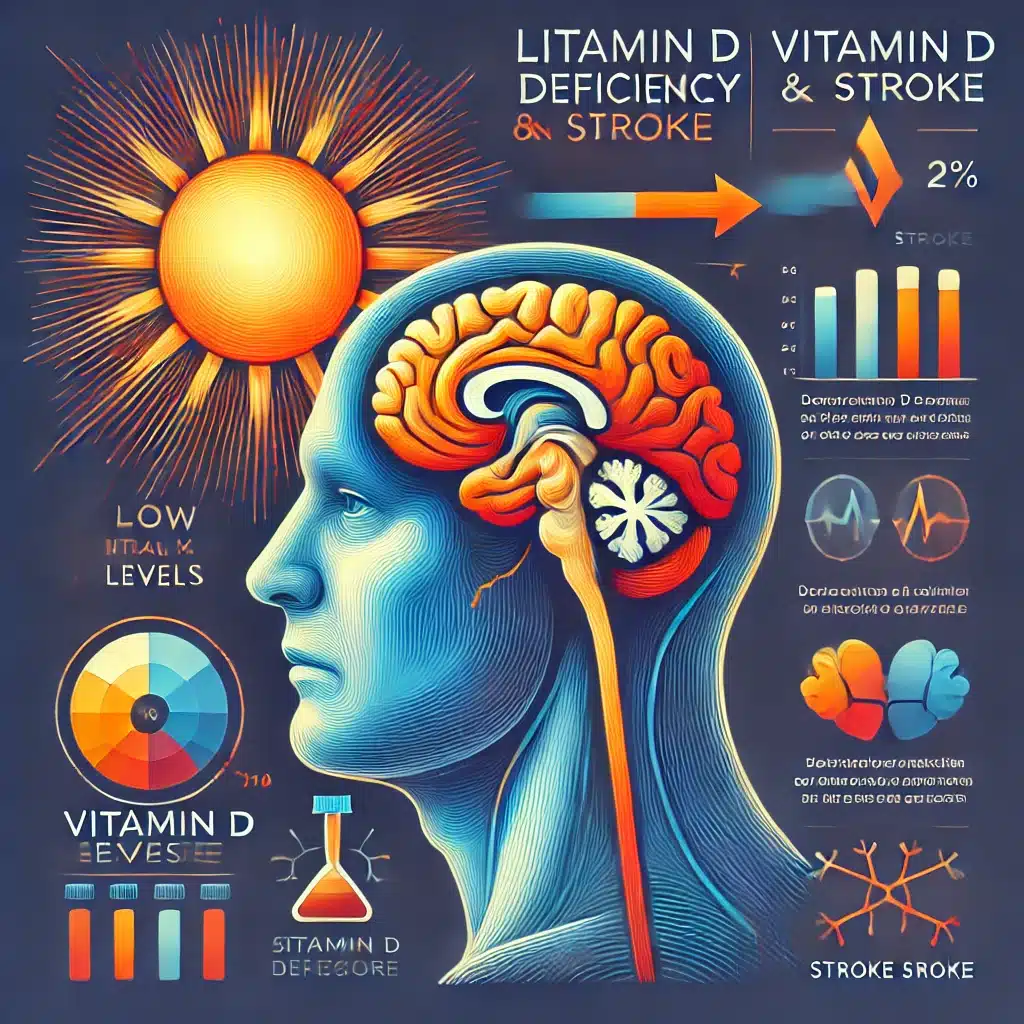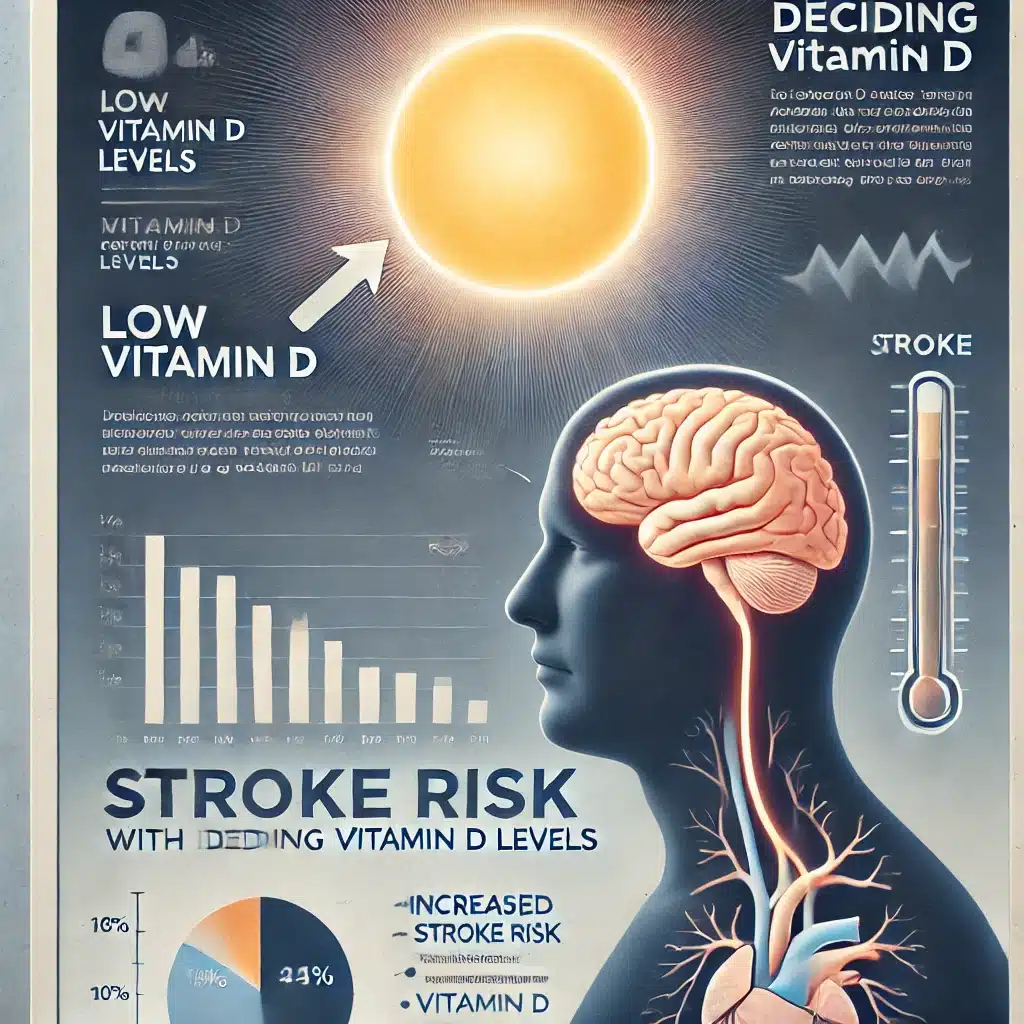TLDR: Lower serum vitamin D levels are associated with an increased risk of stroke, particularly ischemic stroke, and are linked to poorer stroke outcomes.
Highlights:
- The meta-analysis included 27 studies with 45,302 participants, finding a combined relative risk (RR) of 1.28 for stroke risk associated with low vitamin D levels.
- A lower level of serum vitamin D was linked to a worse prognosis for stroke patients, with an RR of 2.95.
- No significant association was found between low vitamin D levels and the risk of hemorrhagic stroke (RR: 1.93).
- Reduced vitamin D levels were significantly linked to an increased risk of ischemic stroke (RR: 1.72).
Source: Brain & Behavior (2024)
Detailed Findings: Vitamin D Levels & Stroke Risk (2024 Analysis)
1. Increased Overall Stroke Risk
Finding: Lower levels of serum vitamin D are associated with a higher risk of stroke.
Statistic: The relative risk (RR) for stroke in individuals with reduced vitamin D levels is 1.28 (95% confidence interval (CI): 1.15–1.42).
Explanation: This means that people with low vitamin D levels are 28% more likely to suffer from a stroke compared to those with higher vitamin D levels.
2. Ischemic Stroke Risk
Finding: Low serum vitamin D levels are significantly linked to an increased risk of ischemic stroke.
Statistic: The RR for ischemic stroke is 1.72 (95% CI: 1.08–2.73).
Explanation: Individuals with low vitamin D levels have a 72% higher risk of experiencing an ischemic stroke, which is caused by a blockage in the blood supply to the brain.
3. Hemorrhagic Stroke Risk
Finding: There is no significant association between low vitamin D levels and the risk of hemorrhagic stroke.
Statistic: The RR for hemorrhagic stroke is 1.93 (95% CI: 0.95–3.95).
Explanation: The data does not show a clear increase in the risk of hemorrhagic stroke, which occurs due to bleeding in the brain, in relation to vitamin D levels.
4. Stroke Prognosis
Finding: Lower serum vitamin D levels are associated with a poorer prognosis in stroke patients.
Statistic: The RR for a worse prognosis after stroke is 2.95 (95% CI: 1.90–4.60).
Explanation: Stroke patients with low vitamin D levels are almost three times more likely to have a poor outcome compared to those with higher levels of vitamin D.
5. Subgroup Analyses
Finding: The connection between low vitamin D levels and stroke risk is more pronounced in ischemic strokes than in hemorrhagic strokes.
Statistic: The RR for ischemic stroke specifically was found to be 1.72, while the RR for hemorrhagic stroke was 1.93 but not statistically significant.
Explanation: This suggests that vitamin D deficiency might play a more critical role in the development of ischemic strokes.
Low Vitamin D Levels & Increased Stroke Risk (Possible Mechanisms)

1. Endothelial Dysfunction
Mechanism: Vitamin D plays a crucial role in maintaining endothelial cell function, which lines the interior surface of blood vessels.
Low levels of vitamin D can lead to endothelial dysfunction, reducing the ability of blood vessels to dilate properly.
This can contribute to atherosclerosis (hardening and narrowing of the arteries), a major risk factor for ischemic stroke.
2. Inflammation and Immune Response
Mechanism: Vitamin D has anti-inflammatory properties and helps regulate the immune response.
Deficiency in vitamin D may result in increased levels of inflammatory cytokines and a heightened immune response, leading to inflammation in blood vessels.
Chronic inflammation can damage the blood vessels and contribute to stroke risk.
3. Blood Pressure Regulation
Mechanism: Vitamin D is involved in the regulation of the renin-angiotensin-aldosterone system (RAAS), which controls blood pressure.
Low vitamin D levels can lead to dysregulation of RAAS, resulting in higher blood pressure.
Hypertension is a well-known risk factor for both ischemic and hemorrhagic strokes.
4. Calcium Homeostasis
Mechanism: Vitamin D is essential for calcium absorption and homeostasis.
Insufficient vitamin D can lead to disrupted calcium balance, which may contribute to vascular calcification and increased arterial stiffness.
These conditions can impede proper blood flow to the brain, increasing the risk of stroke.
5. Neuroprotection
Mechanism: Vitamin D has neuroprotective effects, including reducing oxidative stress and enhancing neuronal repair mechanisms.
Low levels of vitamin D can weaken these neuroprotective effects, making the brain more vulnerable to damage from ischemic events.
This can exacerbate the impact of stroke and hinder recovery.
Study Details: Stroke Risk & Vitamin D Levels (2024)

Sample
Total Participants: 45,302
Total Studies: 27 studies included
Focus: 20 studies focused on stroke risk, while 7 studies examined stroke prognosis.
Types of Studies:
- Cohort studies: 19
- Case-control studies: 6
- Randomized Controlled Trials (RCTs): 1
Methods
Database Search:
- Three electronic databases (Cochrane Library, EMBASE, PubMed) were searched.
- Timeframe: From inception until July 29, 2022.
Inclusion Criteria:
- Studies published in English.
- Human subjects.
- Case-control, cohort, or RCT designs.
- Clear inclusion criteria for ischemic or hemorrhagic stroke.
- Diagnosis of stroke confirmed by CT or MRI.
- Availability of complete data.
Data Extraction:
- Two independent investigators conducted the quality assessment and data extraction.
- The Newcastle–Ottawa Scale (NOS) was used for evaluating cohort and case-control studies.
- The Cochrane risk-of-bias tool was used for RCTs.
Statistical Analysis:
- Relative Risk (RR) and 95% Confidence Intervals (CIs) were calculated.
- Heterogeneity was assessed using the I² statistic and Q test.
- Random-effects model was used for all analyses.
Limitations
- High Heterogeneity: Significant heterogeneity was observed among the included studies (I² > 50% in several analyses). Sources of heterogeneity included study design differences (cohort, case-control, RCTs) and varying sample sizes.
- Publication Bias: Funnel plot analysis indicated potential publication bias, particularly in case-control studies and RCTs with smaller sample sizes.
- Sample Size and Sex: Sensitivity analyses revealed that studies with smaller sample sizes and high proportions of female participants contributed to heterogeneity.
- Exclusion Criteria: Excluding studies with participants having major illnesses or a history of vitamin D intake altered the results, indicating these factors may influence the findings.
- Geographical and Dietary Differences: Variations in dietary habits, sunlight exposure, and regional differences in vitamin D levels among participants could affect the generalizability of the results.
Considerations Based on Study Findings (Vitamin D Levels to Prevent Stroke?)
1. Routine Vitamin D Screening
Incorporate regular vitamin D level screenings in routine health check-ups, especially for individuals at higher risk for stroke.
Focus on elderly populations, individuals with limited sun exposure, those living in higher latitudes, and patients with chronic conditions.
2. Dietary Modifications
Encourage the consumption of foods high in vitamin D, such as fatty fish (salmon, mackerel), fortified dairy products, egg yolks, and mushrooms.
Advocate for the fortification of commonly consumed foods, like milk, orange juice, and cereals, with vitamin D.
3. Supplementation
Develop individualized vitamin D supplementation plans based on serum levels, age, health status, and geographic location.
Launch campaigns to raise awareness about the benefits of vitamin D supplements, particularly in populations with known deficiencies.
4. Safe Sun Exposure
Provide guidelines on safe sun exposure practices to help individuals synthesize adequate vitamin D naturally.
Educate the public on balancing sun exposure to avoid risks of skin cancer while ensuring sufficient vitamin D production.
5. Healthcare Integration
Include vitamin D level assessments in comprehensive stroke risk evaluation protocols in clinical settings.
Integrate vitamin D monitoring and management into overall health and wellness programs, especially for individuals with cardiovascular risks.
6. Post-Stroke Rehabilitation
Ensure regular monitoring of vitamin D levels in stroke patients as part of their rehabilitation process.
Provide nutritional counseling and support to optimize vitamin D intake during recovery, potentially improving outcomes.
Correlation or Causation? Low Vitamin D & Stroke Risk
While this study establishes a strong correlation between low vitamin D levels and increased stroke risk, it does not definitively prove causation.
The observational nature of the included studies means that while an association is evident, it cannot be conclusively stated that low vitamin D levels directly cause strokes.
Confounding factors such as underlying health conditions, dietary habits, and geographic variations in sunlight exposure could also influence the observed relationship.
Therefore, while the findings are compelling and suggest a potential causal link, more controlled experimental studies are needed to establish a definitive cause-and-effect relationship.
Conclusion: Low Serum Vitamin D & Stroke
This study demonstrates a significant association between low serum vitamin D levels and an increased risk of ischemic stroke, as well as poorer prognosis for stroke patients.
The findings suggest that maintaining adequate vitamin D levels could be crucial for stroke prevention and recovery.
Despite the robust sample size and comprehensive analysis, the study is not without limitations, including high heterogeneity and potential publication bias.
These results underline the importance of routine vitamin D screening and supplementation as part of stroke risk assessment and management strategies.
Further research is needed to confirm these findings and explore the mechanisms by which vitamin D influences stroke risk and outcomes.
References
- Study: A systematic review and meta-analysis of the linkage between low vitamin D and the risk as well as the prognosis of stroke (2024)
- Authors: Jianrong Xiong et al.







